http://userealbutter.com/2012/02/12/taiwanese-beef-noodle-soup-recipe/
beef shank, beef marrow bones, green onions, ginger, garlic, thai bird chiles
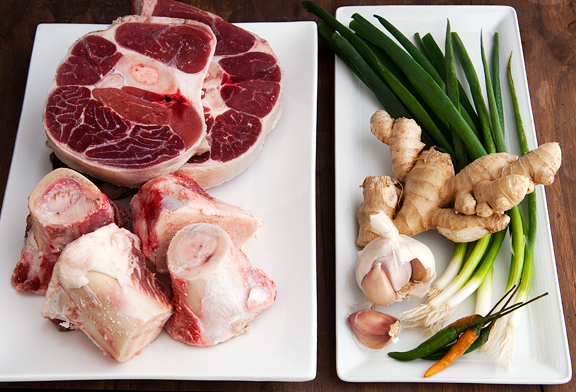
soy sauce, soy paste, dark soy sauce, chili black bean sauce, fermented bean curd, tomato paste
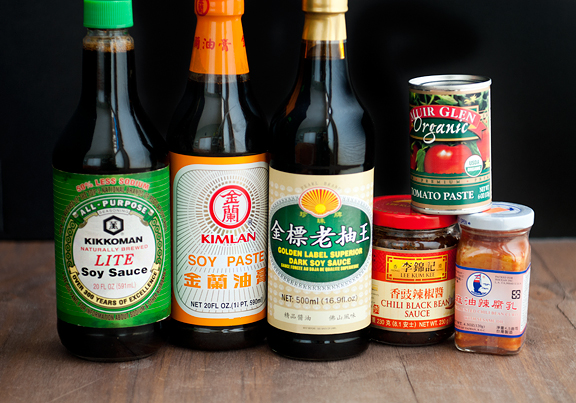
brown sugar, star anise, cinnamon sticks, dried orange peel, bay leaves, fennel seeds, cinnamon bark, sichuan peppercorns, black peppercorns

I’ve had a variety of homemade and restaurant versions of this beloved soup. I’ve flipped through many recipes and never found one that really called to me, until the other day when Carolyn posted a link to Chef Hou Chun-sheng’s winning spicy beef noodle soup recipe. Winning, because Chef Hou dusted his competitors at the Taipei International Beef Noodle Festival in 2011. I had most of the spices, but for those in short supply or those I didn’t have, I knew where to go.
got some more fennel seeds, bay leaves, cinnamon sticks, and picked up cassia bark

from savory spice shop, of course
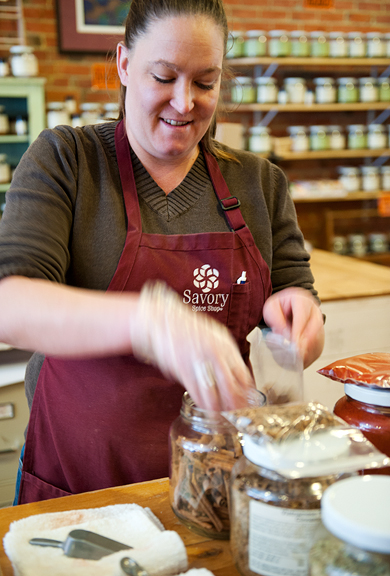
chinese herb bags: cinnamon stick, cinnamon bark, orange peel, anise, fennel seeds, sichuan peppercorns

Savory Spice Shop in Boulder always has what I’m looking for. However, there were two items that I think are pretty specific to Chinese herbal medicine stores: the cassia buds and the angelica root. They didn’t have them (although they looked them up and told me what they were) and I decided it wasn’t worth the scavenger hunt at the Asian markets. My parents hadn’t heard of those either and my dad suggested I omit them. I don’t know if this is kosher or not, but I dried my own organic orange peel. I got beef marrow bones because the butcher said it would lend a deeper flavor to the broth. This soup is ALL about the broth. It costs more, but I am convinced it is worth it. As for beef shank, I rarely find whole beef shank anywhere but in the Asian markets, so I picked up a few pounds of the bone-in cut beef shank.
make broth from the bones

aromatics: green onions, ginger, garlic, thai bird chiles
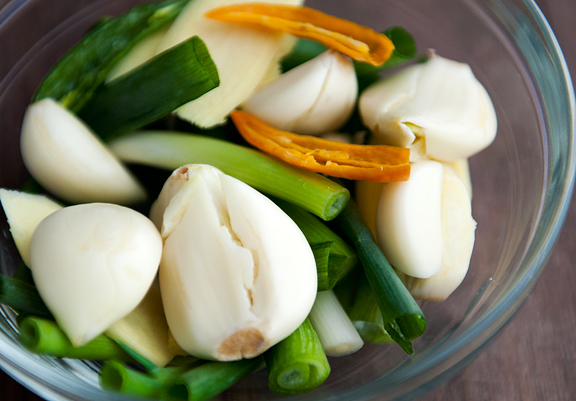
adding soy sauce, brown sugar, and hot bean paste to the sautéed aromatics
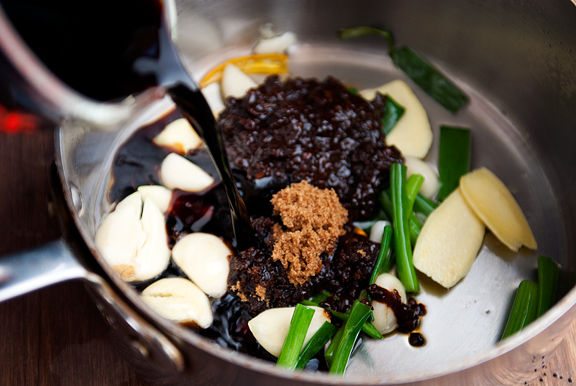
Now, you can make this in one longish day or you can make this over the course of two days. It really depends on a couple of factors: 1) if you use a conventional stock pot or if you use a pressure cooker and 2) if you defat the broth and sauce (at all, the quick way, or the slow way). Personally, I feel the pressure cooker is the better choice because it is so much faster, more energy efficient, and achieves a tenderness in the beef that is effortless. Physics. It is totally your BFF.
let the sauce cook for a minute
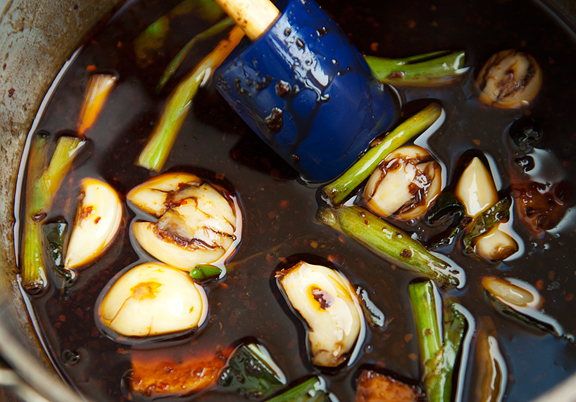
then pour it into the beef stock
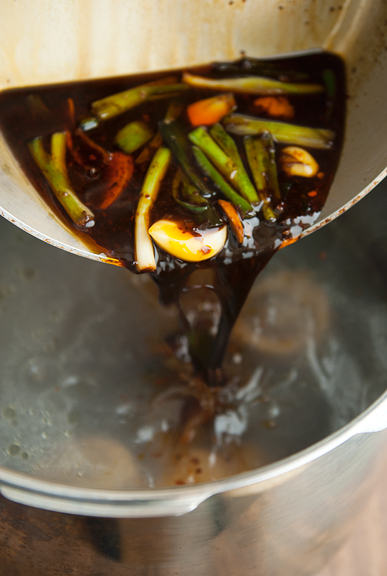
add fermented tofu, tomato paste, herb bag, bay leaf, and black peppercorns to the broth
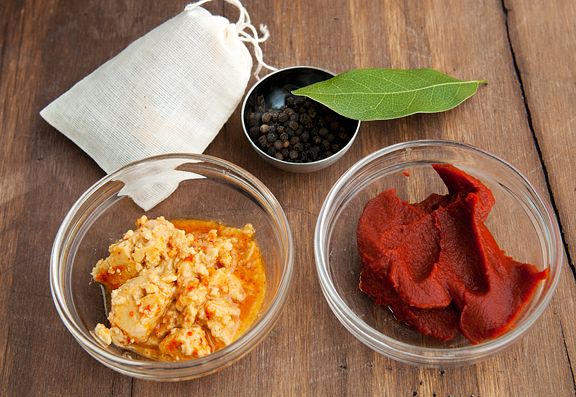
The stock can either simmer for 6 hours in the stock pot, or go 30 minutes in the pressure cooker (and then another 30 minutes on natural decompression). Six hours versus one hour? Did I ever mention how much I love my pressure cooker? Regardless of which method you choose, when you first boil the bones in water, you need to skim off the scum that surfaces for the first ten or fifteen minutes. The beef stock is part 1. Now on to part 2, which is the beef sauce.
add enough water to cover the beef shanks

cooked through
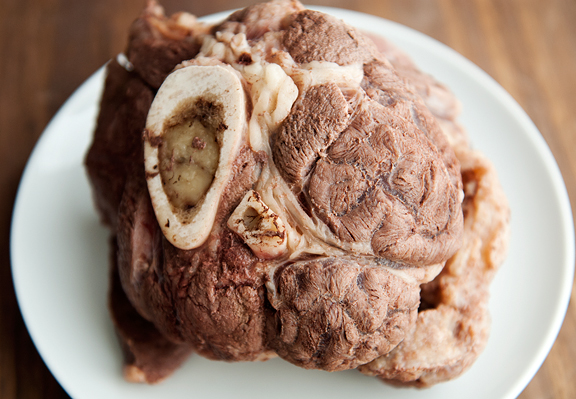
You will need another pot if your beef stock is cooking on the stove. If you can, use a pressure cooker. I don’t have two (yet), but if I did, I would have done this in my second pressure cooker. The beef shanks are boiled in water until they are cooked through. Remove the shanks and strain the beef water into another vessel. Don’t throw the beef water out – it’s got flavor. I think if I had found whole shanks, I might not need to have strained the water. Because I had bone-in shanks, I wanted to remove any potential bone bits and junk from the beef water by straining it through a fine-mesh sieve (you will use the sieve a lot for this recipe). Wipe the pot down and sauté the remaining half of the aromatics just like you did for the beef broth, then add the sugar, hot bean paste, and soy sauce.
stir in fermented bean curd, dark soy sauce, and soy paste

add the black peppercorns, bay leaf, herb bag, and the beef
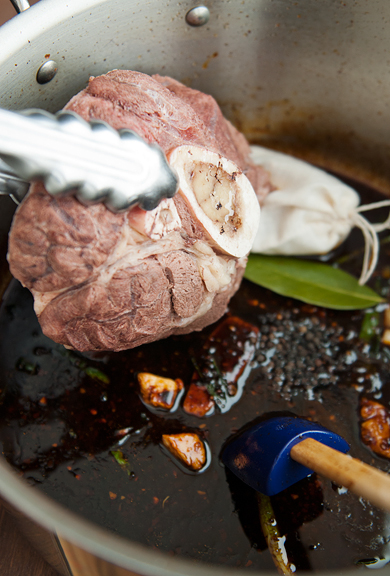
pour in the beef water
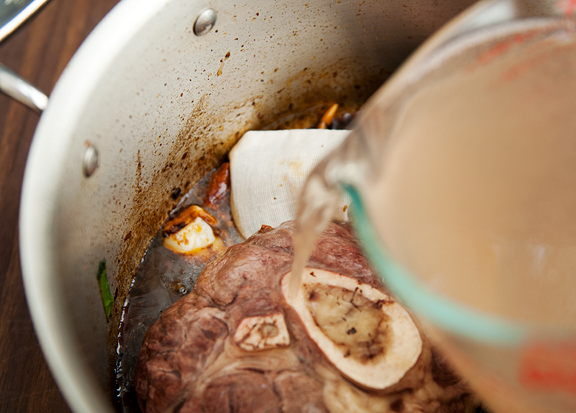
The recipe calls for adding just enough beef water, but I added all of it. Also, before I started blogging, I never knew there was anything other than soy sauce. Now I know there is soy paste, soy sauce, dark soy sauce, light soy sauce, thick soy sauce… And they are all in my cupboard and refrigerator. Right, so you let the beef simmer for 30 minutes or another 2 hours if you want it tender. Take it from me – you want it tender. There is something quite magical when meat reaches that “falling off the bone” tenderness stage. Barbecue aficionados know of what I speak. I waited for my pressure cooker to finish its first job (the broth) before putting it to work on the beef. I set it on high for 30 minutes with a natural decompression (another 30 minutes).
broth is done (nearly clean bone)
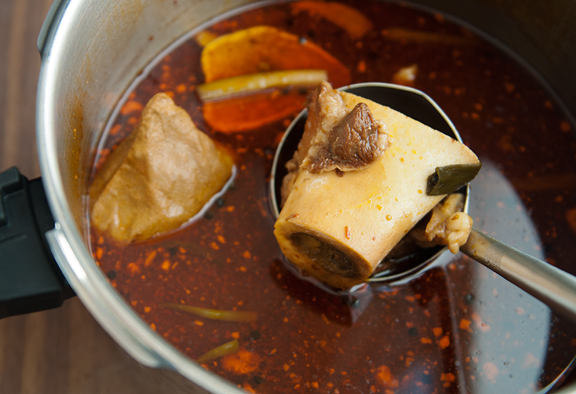
strained broth
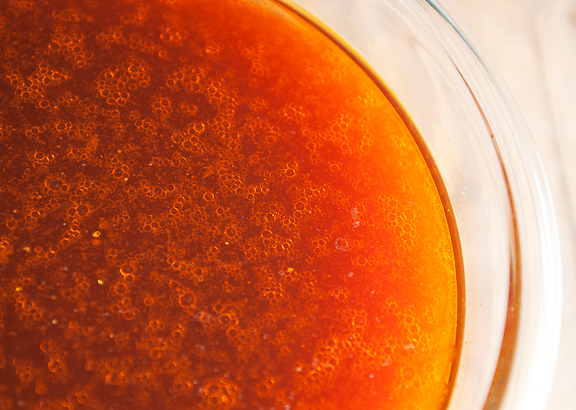
removing fat from the chilled broth
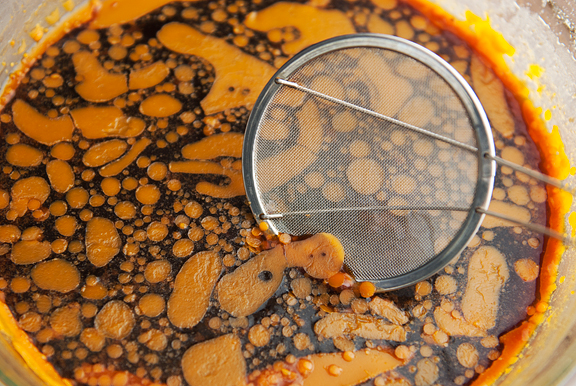
I defat all of my homemade broths. My mom always does this and I think the end product is healthier. Maybe it’s just habit, but I think it is a good one. It does requires a few extra steps. The photo above shows how you defat by chilling the broth (I put it on my deck which was reading 10°F) and skimming off the solidified fat. Another favorite method which is much faster is the ziploc bag trick where you pour hot broth into a giant ziploc, seal it, then pierce a hole at the bottom corner and drain the broth into a vessel, pinching the corner shut right as the fat layer reaches it. I give more detailed instructions in the recipe below. When the beef is done, I take the beef out of the sauce and remove any connective or fatty tissue from the meat. Strain the sauce through a fine-mesh sieve and defat it. At this point you should have tender beef, beef broth, and beef sauce. The soup base is 4 parts beef broth to 1 part beef sauce. Now let’s gather the noodles and all of the goodies. Toppings can include lettuce, chopped tomatoes, fresh cilantro…
my favorite toppings: black bean hot sauce, chili oil, baby bok choy, green onions

cooked noodles, broth, sauce, beef, chili oil, sautéed bok choy, green onions, hot sauce

ladling beef broth over the noodles, bok choy, and beef

a drizzle of chili oil

It’s good. It is so good! I made mine spicy, because that’s what Chinese people do. Jeremy had his “plain” and gave it a happy nod of approval, his smile barely keeping in the mouthful of noodles. My parents had expressed their doubts over the phone, but they were equally curious as to how it would turn out. It’s rare that I will actually stamp my feet with joy when I sit down to eat, but this is one happy-making bowl of Taiwanese beef noodle soup.
the happy-maker
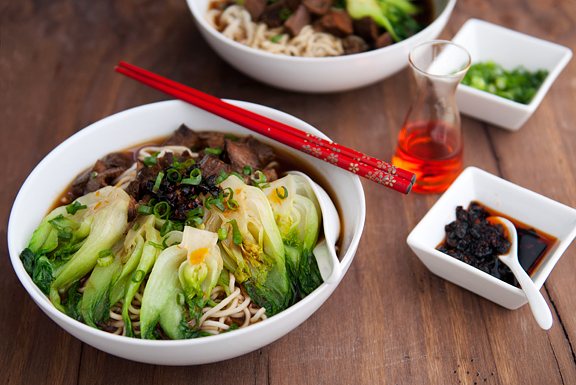
Taiwanese Beef Noodle Soup
[print recipe]
from Chef Hou via Food Gal with lots of my own notes 2.5 lbs. beef bones (mine were beef marrow bones)
2.5 lbs. beef shank (mine had bone in the middle)
herb bags
2 g whole star anise (about 2)
2 g (1 tsp) fennel seeds
2 g angelica roots (I omitted because I couldn’t find it)
2 g dried orange peel (about 4 pieces)
6 g (1 tbsp) Sichuan peppercorns
6 g cassia buds (I omitted because I couldn’t find it)
6 g (1 tbsp) cinnamon bark
6 g cinnamon sticks (two 3-inch sticks)
aromatics and such
4 tbsps vegetable oil
6 green onions, 4 chopped into 3-inch pieces, 2 finely sliced for topping
12-14 garlic cloves, peeled and smashed
2-inch piece of ginger, peeled and sliced lengthwise about 1/8-inch thickness
4 Thai bird chiles, halved and seeded
1 oz rock sugar or 2 tbsps dark brown sugar
3/4 cup hot bean paste
1 cup soy sauce
1/2 cup spicy fermented bean curd
1/4 cup tomato paste
1 tbsp black peppercorns
2 large Bay leaves
4 1/2 tbsps soy paste
2 1/2 tbsps dark soy sauce
to serve
noodles of your choice
baby bok choy for garnish (optional)
chili oil for garnish (optional)
other spicy chili pastes of your liking (optional)
fresh cilantro for garnish (optional – I omitted)
Equipment: Either way, you’re going to be washing a lot of dishes. You will need: a large stock pot or pressure cooker – two is preferable if you’re into multi-tasking (which I am), a medium saucepan, a mesh skimmer, a fine-mesh sieve, and two cloth spice bags.
Chinese herb bags: [You don't have to use herb bags if you plan on straining your broth and sauce.] Split all of the herb bag ingredients in half and place the halves in two separate spice bags. Each bag should contain approximately: 1 whole star anise, 1/2 teaspoon fennel seeds, 1 gram angelica roots (I omitted because I couldn’t find this), 2 pieces of dried orange peel, 1/2 tablespoon Sichuan peppercorns, 3 g cassia buds (I omitted because I couldn’t find this), 1/2 tablespoon cinnamon bark, and one 3-inch cinnamon stick. Tie the bags off.
Make the beef broth: Place the beef bones and a gallon of water in a large stock pot or the pot of pressure cooker. Bring the water to a boil and skim off the scum that accumulates on the surface for about 10-15 minutes or until the scum production reduces considerably. Let it continue to boil gently while you work on the aromatics. In a medium saucepan, heat 2 tablespoons of the vegetable oil and sauté half of the: green onions, ginger, garlic, and Thai bird chiles until fragrant. Then add half of the: sugar, hot bean paste, and soy sauce. Let it all simmer for a minute and then pour the contents into the beef broth. Stir half of the fermented bean curd and all of the tomato paste into the broth. Add half of the black peppercorns, one bay leaf, and one bag of Chinese seasonings to the broth. If cooking with a conventional stock pot, simmer the broth for 6 hours. If cooking with a pressure cooker, I let it cook on high (Fagor setting 2) for 30 minutes and natural decompression. Strain the broth with a sieve. Discard the solids.
Defatting the broth (optional): I like to defat my broth and there are a couple of tricks I use. The first and fastest is to set a gallon-size ziploc bag in a bowl or container with high sides. Pour the broth into the bag taking care not to spill. Don’t fill it up, leave it a cup or two shy of capacity. Seal the ziploc and make sure you don’t squeeze it from the bottom, busting the seal open and spilling hot broth all over the place. Holding the ziploc from one of the top corners, you should have a bottom corner pointed down toward a large, clean vessel to capture the broth. It’s highly advisable to do this in your sink. By now you should see the fat separating into a nice layer on the top. Lower the bottom corner of the bag into the vessel (if it’s too far above the vessel, you will spray broth all over the place) and with the tip of a very sharp knife, poke a little hole just 1/8-inch above the corner. The broth should spill slowly into the vessel as you hold it from the top. If you’re comfortable with the method, make the hole bigger and let the broth drain faster. As the fat layer approaches the hole, pinch it off with your fingers. Discard the fat and ziploc. If you had more broth than would fit into the first ziploc, repeat with a second bag until you are done defatting all of the broth. The second method is less wasteful, but takes longer. Essentially, you want to cool the broth until the fat (which floats to the top) solidifies so you can skim it off. I really hate putting such a large volume of warm broth in my refrigerator and since I only make these kinds of soups in winter, I just cover it with a lid or plastic wrap and let it cool on my deck which ranges anywhere from -25°F to 30°F for a good fraction of the year. [Note: My deck is a 2nd story deck and has no "access" from the ground floor. I would never put it on my front doorstep. If you live in a place where critters abound, I wouldn't recommend putting it outside unattended where said critters could get into your delicious broth.]
Cook the beef shank and make the beef sauce: Place the beef shank in a pot or saucepan and fill with enough water to just cover the beef. Boil the beef shank until the meat is cooked through. If using whole shanks, remove the beef from the water and slice into disks about 1 1/2 inches in thickness (Chef Hou says 1/3-inch thick, but I like the beef thicker). If using beef shank cuts, just remove from the water and set aside. Save the beef water. In a large saucepan, stock pot, or pressure cooker pot, heat 2 tablespoons of vegetable oil and sauté the remaining green onions, ginger, garlic, and Thai bird chiles until fragrant. Add the rest of the sugar, hot bean paste, and soy sauce. Let cook for a minute. Stir in the remaining fermented bean curd, all of the soy paste, and all of the dark soy sauce. Lastly, add the rest of the black peppercorns, one bay leaf, and the other Chinese herb bag. Place the beef in the stock pot or pressure cooker containing the sauce. Add all of the beef water and stir to make sure it mixes with the sauce. If cooking with a conventional stock pot or saucepan, cover with lid and simmer for at least 30 minutes. If you want the meat to be tender, let it cook for another couple of hours, but check on the water levels to make sure they don’t get too low. If cooking with a pressure cooker, your only option is tender meat. Again, I let mine cook on high (Fagor setting 2) for 30 minutes with natural decompression. If using bone-in shank, the meat should fall off the bone when it is done. While the beef is warm, I like to discard any fat or connective tissue from the meat, reserving the lean beef in a separate vessel. Strain the sauce through a sieve and discard the solids. Follow the defatting process as listed above for the beef broth if desired.
Assembly: Bring fresh water to a boil and cook your noodles (fresh or dried). Drain the noodles and let cool. Blanch or sauté baby bok choy and set aside. Combine 4 parts beef broth with 1 part beef sauce in a saucepan. Add beef to the broth and bring to a boil. Remove from heat. Place noodles in a bowl and top with beef shank, bok choy, and chopped green onions. Ladle the broth-sauce over the noodles. Drizzle some hot chili oil over top (purely optional, but mandatory in my book) and serve with more hot chili sauce on the side. Serves 10-12. Makes about 10 cups of broth and 8 cups of sauce.
No comments:
Post a Comment